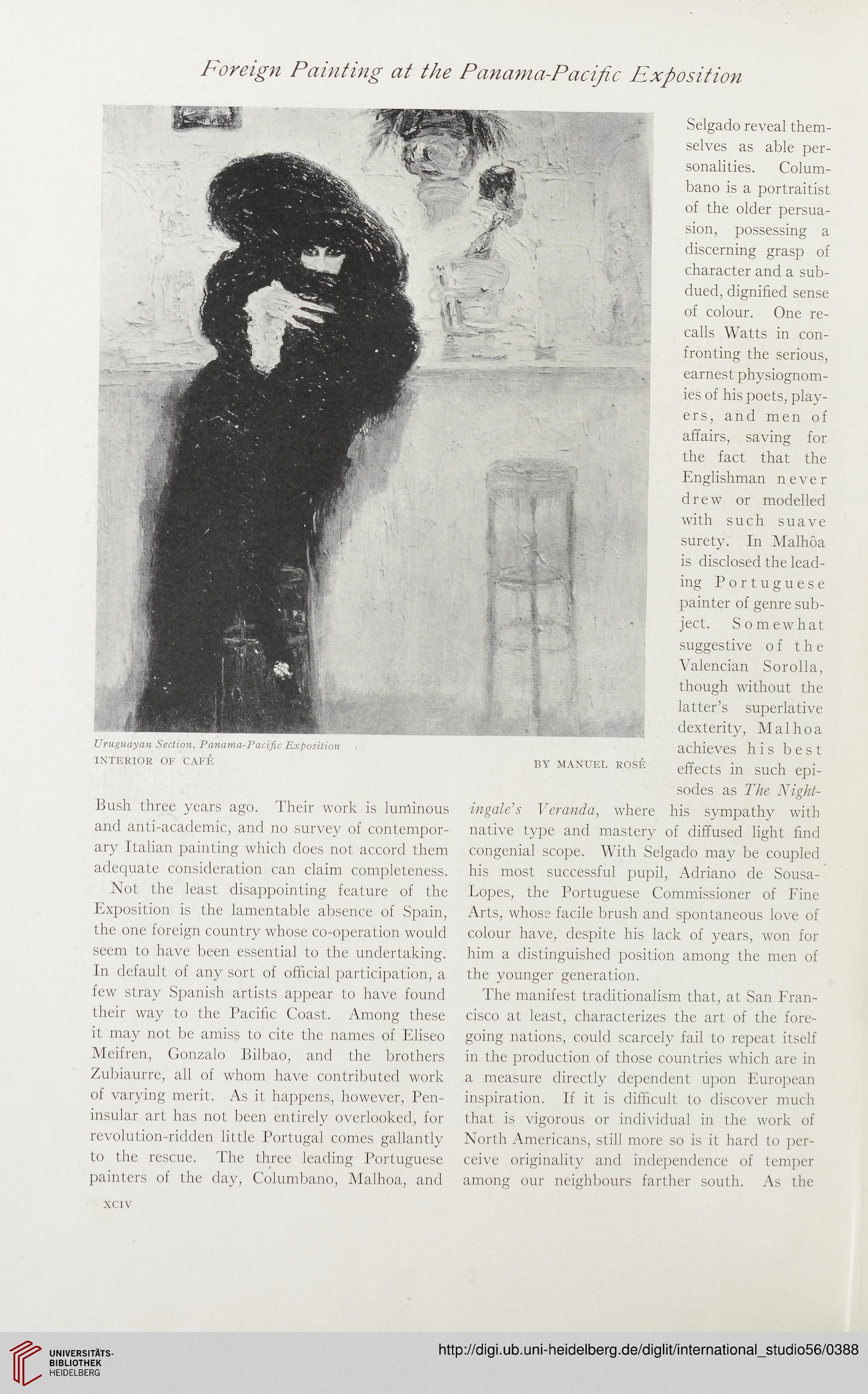Foreign Painting at the Panama-Pacific Exposition
BY MANUEL ROSE
Uruguayan Section, Panama-Pacific Exposition
INTERIOR OF CAFE
Selgado reveal them-
selves as able per-
sonalities. Colum-
bano is a portraitist
of the older persua-
sion, possessing a
discerning grasp of
character and a sub-
dued, dignified sense
of colour. One re-
calls Watts in con-
fronting the serious,
earnest physiognom-
ies of his poets, play-
ers, and men of
affairs, saving for
the fact that the
Englishman never
drew or modelled
with such suave
surety. In Malhoa
is disclosed the lead-
ing Portuguese
painter of genre sub-
ject. Somewhat
suggestive of the
Valencian Sorolla,
though without the
latter’s superlative
dexterity, Malhoa
achieves his best
effects in such epi-
sodes as The Night-
his sympathy with
Bush three years ago. Their work is luminous
and anti-academic, and no survey of contempor-
ary Italian painting which does not accord them
adequate consideration can claim completeness.
Not the least disappointing feature of the
Exposition is the lamentable absence of Spain,
the one foreign country whose co-operation would
seem to have been essential to the undertaking.
In default of any sort of official participation, a
few stray Spanish artists appear to have found
their way to the Pacific Coast. Among these
it may not be amiss to cite the names of Eliseo
Meifren, Gonzalo Bilbao, and the brothers
Zubiaurre, all of whom have contributed work
of varying merit. As it happens, however, Pen-
insular art has not been entirely overlooked, for
revolution-riclden little Portugal comes gallantly
to the rescue. The three leading Portuguese
painters of the day, Columbano, Malhoa, and
ingale’s Veranda, where
native type and mastery of diffused light find
congenial scope. With Selgado may be coupled
his most successful pupil, Adriano de Sousa-
Lopes, the Portuguese Commissioner of Fine
Arts, whose facile brush and spontaneous love of
colour have, despite his lack of years, won for
him a distinguished position among the men of
the younger generation.
The manifest traditionalism that, at San Fran-
cisco at least, characterizes the art of the fore-
going nations, could scarcely fail to repeat itself
in the production of those countries which are in
a measure directly dependent upon European
inspiration. If it is difficult to discover much
that is vigorous or individual in the work of
North Americans, still more so is it hard to per-
ceive originality and independence of temper
among our neighbours farther south. As the
xciv
BY MANUEL ROSE
Uruguayan Section, Panama-Pacific Exposition
INTERIOR OF CAFE
Selgado reveal them-
selves as able per-
sonalities. Colum-
bano is a portraitist
of the older persua-
sion, possessing a
discerning grasp of
character and a sub-
dued, dignified sense
of colour. One re-
calls Watts in con-
fronting the serious,
earnest physiognom-
ies of his poets, play-
ers, and men of
affairs, saving for
the fact that the
Englishman never
drew or modelled
with such suave
surety. In Malhoa
is disclosed the lead-
ing Portuguese
painter of genre sub-
ject. Somewhat
suggestive of the
Valencian Sorolla,
though without the
latter’s superlative
dexterity, Malhoa
achieves his best
effects in such epi-
sodes as The Night-
his sympathy with
Bush three years ago. Their work is luminous
and anti-academic, and no survey of contempor-
ary Italian painting which does not accord them
adequate consideration can claim completeness.
Not the least disappointing feature of the
Exposition is the lamentable absence of Spain,
the one foreign country whose co-operation would
seem to have been essential to the undertaking.
In default of any sort of official participation, a
few stray Spanish artists appear to have found
their way to the Pacific Coast. Among these
it may not be amiss to cite the names of Eliseo
Meifren, Gonzalo Bilbao, and the brothers
Zubiaurre, all of whom have contributed work
of varying merit. As it happens, however, Pen-
insular art has not been entirely overlooked, for
revolution-riclden little Portugal comes gallantly
to the rescue. The three leading Portuguese
painters of the day, Columbano, Malhoa, and
ingale’s Veranda, where
native type and mastery of diffused light find
congenial scope. With Selgado may be coupled
his most successful pupil, Adriano de Sousa-
Lopes, the Portuguese Commissioner of Fine
Arts, whose facile brush and spontaneous love of
colour have, despite his lack of years, won for
him a distinguished position among the men of
the younger generation.
The manifest traditionalism that, at San Fran-
cisco at least, characterizes the art of the fore-
going nations, could scarcely fail to repeat itself
in the production of those countries which are in
a measure directly dependent upon European
inspiration. If it is difficult to discover much
that is vigorous or individual in the work of
North Americans, still more so is it hard to per-
ceive originality and independence of temper
among our neighbours farther south. As the
xciv




